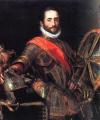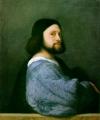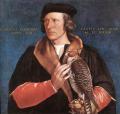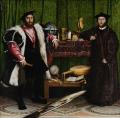| |
|
|
|
Men's portraits 16th century in art and painting
Ferdinand the Catholic, unknown master
The characteristic features of the male portrait of the 16th century reflect the historical and cultural context of that period. Here are a few basic features that can be distinguished:
1. Clothing and accessories: Men in portraits of the 16th century were often depicted in luxurious and elaborate costumes. An important role was played by such elements as a fur mantle or vest, embroidery, jewelry, feathers on a hat and dapper accessories.
2. Poses and facial expressions: Most of the male portraits were quite formal and serious. Men were often depicted standing or sitting with a straight posture and a serious expression. It reflected social status, power and dignity.
3. Accentuated facial features: Attention was paid to working out the details of the face, especially the eyes, nose and mouth. Displaying the expressiveness of facial features was an important aspect of the portrait.
4. Symbols of power and achievements: Often men in portraits of the 16th century were presented with the attributes of their social status or profession. Additional elements could include orders, military armor, books, maps, which testified to the character and achievements of this person.
5. Authenticity and realism: During the Renaissance, the trend towards greater realism and authenticity became increasingly prevalent in the portrayal of male portraits. The artists sought to convey the features of appearance with greater accuracy.
The unique features of each artist and region could also influence the features of the male portrait of the 16th century. These are just general observations, and each portrait may contain individual characteristics associated with a specific personality and task of the author.
Hundreds of masterpieces (men's portraits 16th century) with comments and detailed descriptions.
|
|
Pictures:
Portrait of Alof de Wignacourt :: Caravaggio
 |
Warrior with Equerry :: Cavazzola
 |
Portrait of Ottavio Farnese :: Giulio Campi
 |
Pierre Quthe :: Franzois Clouet
 |
Portrait of Two Young Men :: Giovanni Cariani
 |
Portrait of a Man :: Giulio Campi
 |
Portrait of Anthonis van Hilten :: Joos van Cleve
 |
Francesco II della Rovere :: Federico Barocci
 |
Portrait of a Scholar :: Domenico Feti
 |
Portrait of Count Ludwig Loewenstein, 1513 :: Hans Baldung
 |
Hans Baldung, Self-Portrait 1526
 |
Ariosto's portrait
 |
Head of a Man
 |
Portrait of Bindo Altoviti
 |
Portrait of a Man :: Raffaello Sanzio
 |
Pompeius Occo :: Jacobsz, Dirck
 |
Group Portrait of the Amsterdam Shooting Corporation :: Jacobsz, Dirck
 |
Group Portrait of the Amsterdam Shooting Corporation :: Jacobsz, Dirck
 |
Portrait of Emperor Rudolf II
 1590s Oil on canvas, 60 x 48 cm Kunsthistorisches Museum, Vienna |
Portrait of Robert Cheseman
 Location: Mauritshuis Royal Picture Gallery The Hague Netherlands Original Size: unknown |
The Ambassadors (1533)
 Artist: Hans Holbein the Younger Year: 1533 Medium: Oil on oak Dimensions: 207 cm × 209.5 cm (81 in × 82.5 in) Location: National Gallery, London |
Hide Comments (10)
|
|
|
Home-artlib >
|
|
|
|
|
|
|
|
|
510×610
Ugolino Martelli c. 1535 by Agnolo Bronzino , Staatliche Museen, Berlin, Germany
1
Philip I the Beautiful, unknown master
2
In the portraits of the 16th century there is a great freedom - the artists depict the characters in more diverse poses and pay more attention to the details of the surrounding situation. The images look more human, which is promoted by the development of technology, and the faces look more natural.
3
Portrait of Thomas Howard, Duke of Norfolk (1539 - 1540) by Hans Holbein the Younger (1497 - 1543)
Thomas Howard, Duke of Norfolk, statesman and military leader, uncle of Henry VIII's wife, father of poet Henry, Earl of Surrey. All these relatives laid their heads on the scaffold. He wears the Order of the Garter.
Thomas Howard got the title of Lord Admiral. He participated in the victorious battle of Flodene against Scotland (1513), under the command of his father fought with the [Expand]
Howard inherited his father's title of Duke of Norfolk, took the place of his father as Lord High Treasurer and Earl Marshal. He had a difficult fate. Howard was against the Reformation Church, begun by King Henry VIII, and together with his elder son Henry, Earl of Surreem was imprisoned in London prison Tower. The son was soon executed, and then Howard himself waited for a scaffold. But the day before the execution of the King died. So Norfolk was saved, but sitting in jail for another 6 years.
In the portrait, Thomas Howard is dressed in a luxurious fur coat. Her face is dark, with a big crooked nose, tight lips, look of dark eyes is hard and a little tired.
4
Portrait of Charles de Solier, Sieur de Morette
Before us is the French ambassador to the English court of the 16th century, Sir Moret Charles de Sollier. For some reason, Holbein did not indicate the name of the model in the portrait and for a long time believed that the Duke of Milan, Leonardo da Vinci was depicted here. And only in the 20th century, it was possible to accurately identify that this is a French ambassador.
This magnificent portrait of Holbein is an acknowledged masterpiece [Expand]
The artwork painted in a strict palette of dark and light brown tones.
5
Portrait of Henry VIII by Hans Holbein the Younger (1497 - 1543)
Henry VIII was English monarch from the Tudor dynasty. Educated and gifted, at the end of his 38-year reign, he severely pursued all those who disagreed with his actions. Most of all he became known as the initiator and conductor of the Reformation of the English Church, which made England overwhelmingly a Protestant nation.
The king had six wives, of whom he divorced from two and sent two to the scaffold on charges of [Expand]
Henry VIII was a controversial figure. He was highly capable in the sciences and music. He played on several musical instruments and sang beautifully.
The artist introduced us to the monarch in a rich, embroidered and decorated with precious stones clothing. King's pose is full of impressive dignity. He is well-built; his posture is proud, straight, in one hand glove, hands in rings.
In the eyes of the King appears mind, imperious nature. It seems he is devoid of emotion, so his face is indifferent calmly. Tightly compressed thin lips speak of strong will, perseverance in the pursuit of their goals.
6
Portrait of Bonifacius Amerbach (1519)
Bonifacius Amerbach is a young humanist, a close friend of Erasmus of Rotterdam. He is a representative of the new European intelligentsia. He is fully developed, educated, spiritually whole. Bonifacius is surrounded by a halo of nobleness. The features of his handsome face are strict, thin.
7
Title : Doge Leonardo Loredan
Object type : painting
Genre : portrait
Description :
Portrait of Doge Leonardo Loredan. Doge of Venice from 1501-21
Depicted people : Leonardo Loredan
Date : circa 1501-1502
Medium : oil on poplar wood
Dimensions : Height: 61.6 cm (24.2 ″); Width: 45.1 cm (17.7 ″)
8
I can’t admire the beauty of a man, but I can praise the artist’s talent. He perfectly depicted a typical man of that time.
9
Tags: male portrait, brown eyes, plump lips, second chin, black hat, brown hair, dark background, gold chain, black jacket, white shirt, thin eyebrows, big nose
10